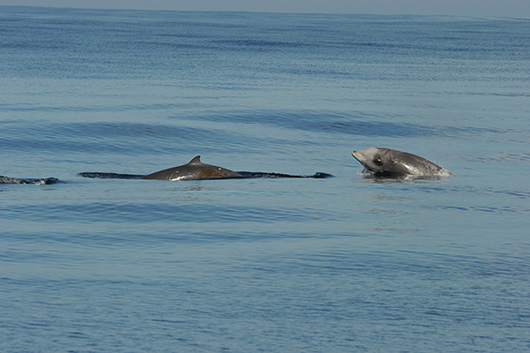Low levels of sonar trigger strong behavioural responses in beaked whales

Credit: Ari S Friedlaender, taken under NMFS permit #14534
An international team of scientists, led by the University of St Andrews, has found that one species of whale may be even more sensitive to military sonar than previously thought.
Their study, published today (July 3) in the journal Biology Letters, shows that Cuvier’s beaked whales responded strongly to simulated mid-frequency sonar sounds.
When whales were exposed to levels well below current regulatory thresholds, they stopped feeding and swam rapidly away from the sound source.
The two whales studied did not forage or resume normal diving behaviour for at least 3-4 hours following the 30-minute controlled sound exposures.
One of these two whales was also incidentally exposed to mid-frequency sonar sounds from a distant naval exercise.
The sounds reached levels similar to those that provoked strong responses during the controlled exposures using a nearby source. However, the distant exercise did not provoke a similar behaviour change.
This result suggests that the context of exposure, possibly including the distance from the whale to the sonar, likely affects the whales’ response.
The team included researchers Professor Peter Tyack of the School of Biology, Len Thomas and Dina Sadykova of the School of Mathematics and Statistics at the University of St Andrews; David Moretti of the US Navy’s Naval Undersea Warfare Center and the University of St Andrews; as well as Dr Brandon Southall, Chief Scientist of research firm Southall Environmental Associates, and a Research Associate with the University of California, Santa Cruz.
Dr Stacy DeRuiter, lead author, of the School of Mathematics and Statistics at the University of St Andrews said: “It was thanks to the hard work of a large, talented team that we were able to collect data on such a hard-to-study species; Ziphius are shy and difficult to track because they routinely dive for over an hour to depths several kilometres below the surface.
“Although we have not been able to study many individuals so far, both of the whales studied responded to simulated sonar with strong, consistent, and sustained avoidance. They postponed foraging to swim rapidly away from the sound source.”
Because beaked whales are difficult to study in the wild, behavioural responses of Cuvier’s beaked whales (Ziphius cavirostris) to mid-frequency military sonar signals have not been measured directly until now, even though the species accounts for 69 per cent of recorded marine mammal strandings associated with military sonar operations.

Credit: John Calambokidis, taken under NMFS permit #14534
Using animal-borne tags that record sound and animal movements, the researchers obtained the first ever controlled and high-resolution measurements of responses of Ziphius to sonar.
John Calambokidis, part of the research team from Cascadia Research, an Olympia, WA non-profit leading the small boat operations use for the tag deployments, said: “This work has important implications for the Navy, which provided support for this work, and may in the long term aid in the search for ways to reduce impacts on this species.”
The data provide a much-needed scientific basis to inform decisions and reduce adverse effects of naval mid-frequency sonar on beaked whales.
These data were collected during the southern California Behavioral Response Study (see: www.socal-brs.org). This study is part of an international, multi-disciplinary research collaboration to understand behavioural patterns in marine mammals and assess potential risk of operational sonar training.
A related paper from the same research team, led by Jeremy Goldbogen of Cascadia Research Collective, USA, published in the Proceedings of the Royal Society (B), reports on the responses of endangered blue whales to simulated mid-frequency military sonar.
Blue whale responses included altered diving and feeding behaviour and temporary avoidance of the area near the sound source. Responses were less pronounced than those measured in beaked whales and were highly context-dependent. However, the findings are somewhat unexpected; blue whales were not previously known to be sensitive to disturbance by mid-frequency sonar sounds, which are much higher-pitched than their own low-frequency communication calls.
Dr Brandon Southall, Principal Investigator of the overall project covering both papers, said: “The two studies provide the first direct measurements of individual responses – for Cuvier’s beaked whales and for any baleen whale species – to these kinds of mid-frequency sonar signals.
“These findings help us to understand risks to these animals from human sound and inform timely conservation and management decisions.”
Note to Editors
Dr Stacy DeRuiter is available on 01334 461814 / 07432 689323.
Dr Brandon Southall is available on +1 831 332 8744.
Images are available – please note the file with credits and information on the individual images.
Blue whale manuscript (Open Access).
Issued by the Press Office, University of St Andrews
Contact Fiona MacLeod on 01334 462108/ 0771 414 0559.
Ref: (whale sonar 03/07/13)
View the University’s latest news at www.st-andrews.ac.uk/news
Category Research